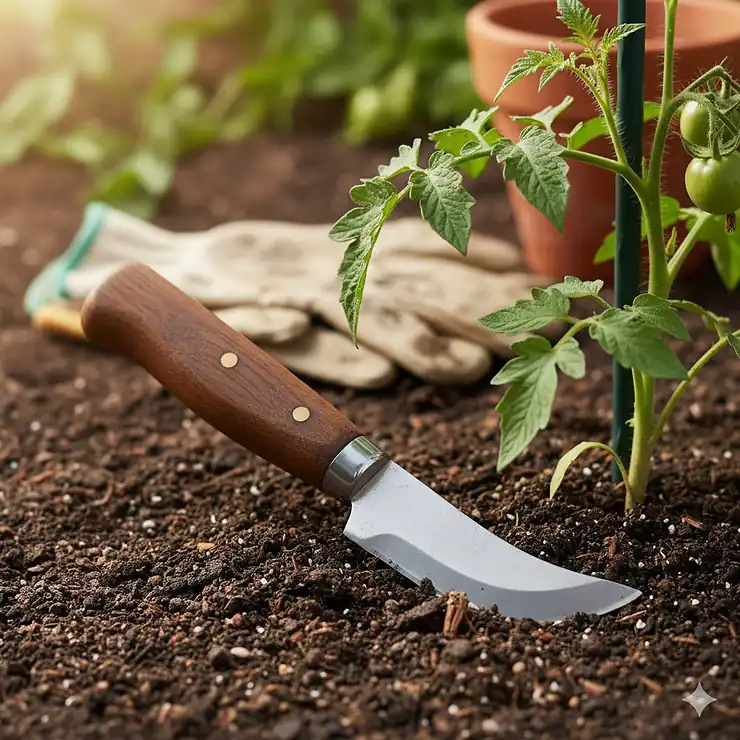In This Article
✨Was this helpful? Spread the word! 🚀
If you’ve ever battled stubborn weeds with a dull trowel or struggled to divide perennials with inadequate tools, you already know the frustration. A proper gardening knife transforms these tedious tasks into effortless work. What exactly is a gardening knife? It’s a versatile, multi-functional tool—often called a hori hori—featuring a sharp blade designed for digging, weeding, cutting roots, and measuring planting depth, all in one compact design.

I remember the first time I used a quality gardening knife. I’d been wrestling with dandelions for what felt like hours, and my back was killing me. Then a fellow gardener handed me her hori hori, and everything changed. The serrated edge sliced through thick taproots like butter, while the curved blade scooped out the entire root system in seconds. That day, I became a convert.
The beauty of knives for gardening lies in their incredible versatility. Unlike single-purpose tools that clutter your shed, one exceptional gardening knife handles weeding, transplanting, dividing plants, cutting twine, opening soil bags, and even measuring proper planting depth. Whether you’re a weekend hobbyist or a professional landscaper, the right tool can save you hours of work and countless backaches.
In this comprehensive guide, we’ll explore seven outstanding products that have earned rave reviews from gardeners across America. From budget-friendly options under $20 to premium models built to last decades, we’ve researched real Amazon products, analyzed customer feedback from verified reviews, and compared specifications following Consumer Reports’ testing methodology to help you find your perfect match. You’ll discover which features matter most, how to choose based on your specific needs, and why investing in quality pays off every single time.
Quick Comparison Table
| Product | Blade Length | Material | Handle Type | Price Range | Rating |
|---|---|---|---|---|---|
| Nisaku NJP650 | 7.25″ | Japanese Stainless Steel | Wood | $35-45 | 4.7/5 |
| Fiskars Hori Hori | 7″ | Stainless Steel | SoftGrip | $25-30 | 4.8/5 |
| PERWIN Hori Hori | 7″ | Stainless Steel | Walnut Wood | $20-36 | 4.8/5 |
| Opinel No. 8 | 3.35″ | Sandvik Steel | Beechwood | $19 | 4.6/5 |
| Garden Guru | 7″ | Stainless Steel | Rosewood | $35-40 | 4.7/5 |
| WORKPRO | 7″ | Stainless Steel | TRP Ergonomic | $20-25 | 4.6/5 |
| Fiskars Big Grip | 7″ | Plated Steel | SoftGrip | $13-15 | 4.2/5 |
🛒 Ready to Transform Your Gardening?
These carefully selected tools are available on Amazon with fast shipping. Click on any highlighted product to check today’s prices and customer reviews. Your perfect gardening companion is just one click away! 🌱✨
💬 Just one click – help others make better buying decisions too!😊
Top 7 Gardening Knife Products: Expert Analysis
1. Nisaku NJP650 The Original Hori Hori – Best Overall
The Nisaku NJP650 stands as the gold standard among garden cutting tools, and for good reason. Manufactured in Japan using authentic Tomita steel (established 1960), this knife delivers professional-grade performance that justifies every penny of its $35-45 price tag.
Key Specifications:
- Blade length: 7.25 inches
- Material: Authentic Japanese stainless steel
- Weight: 10 oz
- Includes: Leather sheath with belt loop
This tool features both straight and serrated edges, making it equally adept at slicing through sod and sawing through thick roots. The inch markings etched into the blade ensure precise planting depth every time. One Amazon reviewer called it “the knife that made me a gardening ninja,” praising how it powers through weeds that defeated other tools.
Pros:
✅ Razor-sharp out of the box
✅ Rust and scratch-resistant blade
✅ Authentic Japanese craftsmanship
Cons:
❌ Higher price point
❌ Wooden handle may require occasional oiling
Customer feedback reveals impressive longevity—many gardeners report using the same Nisaku for 5+ years with minimal maintenance. The comfortable wooden handle provides excellent grip even when wet, though some users note the sheath could be slightly higher quality for the price.
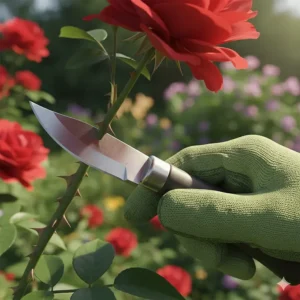
2. PERWIN Hori Hori Garden Knife – Best Value
At just $20-36, the PERWIN Hori Hori delivers heavy-duty performance that punches well above its weight class. This bestseller has sold over 5,000 units in recent months, earning a stellar 4.8-star rating on Amazon.
Key Specifications:
- Blade length: 7 inches
- Full-tang construction
- Walnut wood handle
- Complete with protective leather sheath
The full-tang design means the blade extends completely through the handle, reinforced with three metal rivets for exceptional strength. One side features sharp cutting edge perfect for vegetables and twine, while the serrated opposite side tackles woody stems and tough roots with ease.
Pros:
✅ Exceptional value for money
✅ Full-tang durability
✅ Comfortable ergonomic grip
Cons:
❌ May require periodic sharpening
❌ Handle finish less refined than premium options
Multiple reviews mention this knife’s surprising heft and balance. One gardener wrote: “This is the tool I didn’t know I needed—it handles everything from delicate seedlings to brutal root systems.” The curved blade makes scooping soil effortless, while the depth markings eliminate guesswork when planting bulbs.
3. Fiskars Hori Hori Garden Knife – Best for Durability
Backed by Fiskars’ legendary lifetime warranty, the Fiskars Hori Hori ($25-30) combines Scandinavian engineering with practical garden-tested features. This is the knife you’ll still be using when other tools have long since retired.
Key Specifications:
- Corrosion-resistant stainless steel
- Extended tang for added strength
- SoftGrip handle reduces fatigue
- Hard plastic sheath with belt loop
The precision-ground edge handles multi-purpose cuts while the serrated section saws through thick growth without hesitation. The forked tip makes weeding particularly efficient, gripping stubborn roots for clean extraction. Easy-to-read measurements in both inches and centimeters serve international gardeners well.
Pros:
✅ Lifetime warranty
✅ Ergonomic SoftGrip handle
✅ Corrosion-resistant construction
Cons:
❌ Plastic sheath less premium than leather
❌ Heavier than ultra-lightweight options
Customers consistently praise the comfortable grip during extended use. One professional landscaper noted: “I’ve used this knife daily for three seasons, and it still feels brand new. The warranty is real—Fiskars replaced my first one when I accidentally left it outside all winter.”
4. Opinel No. 8 Garden Knife – Best Folding Option
The Opinel No. 8 ($19) brings French elegance and portability to American gardens. This folding gardening knife fits comfortably in your pocket, making it perfect for gardeners who prefer carrying tools discreetly or working in multiple locations.
Key Specifications:
- Blade length: 3.35 inches (8.5cm)
- Sandvik 12C27 modified stainless steel
- Varnished beechwood handle
- Virobloc safety ring locks blade open/closed
Despite its compact size, this little powerhouse handles surprising tasks. The pointed blade excels at precision work like cutting flowers, harvesting herbs, and trimming delicate plants. The Yatagan blade shape, inspired by Turkish sabers, provides excellent cutting geometry that stays sharp through extended use.
Pros:
✅ Ultra-portable folding design
✅ French craftsmanship since 1890
✅ Safety lock for secure carry
Cons:
❌ Smaller blade limits heavy digging
❌ Requires cleaning after exposure to moisture
Gardeners love this knife for harvesting tasks. One reviewer noted: “Perfect for snipping herbs and flowers throughout the day. I keep it in my pocket and forget it’s there until I need it—then it’s instantly ready.” The wooden handle develops a beautiful patina over time, adding character while maintaining grip.
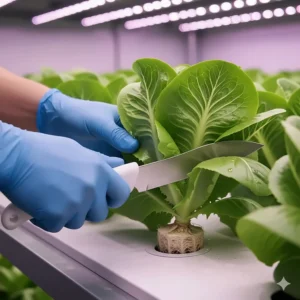
5. Garden Guru Hori Hori Gardening Knife – Best Premium Choice
The Garden Guru Hori Hori ($35-40) represents the pinnacle of American-made quality, backed by an impressive lifetime warranty and 90-day satisfaction guarantee from a veteran-owned company.
Key Specifications:
- Full-tang stainless steel construction
- Premium rosewood handle
- Rust-resistant blade
- Comes with woven nylon sheath
This knife stands out for its environmental commitment—it’s certified carbon neutral, and the company donates 1% of sales to environmental protection through their 1% For The Planet membership. Beyond the ethics, the tool simply performs beautifully. The full-tang blade extends the entire handle length, providing unmatched leverage when prying stubborn roots or breaking through compacted soil.
Pros:
✅ Lifetime warranty
✅ Carbon-neutral certified
✅ Exceptional customer support
Cons:
❌ Premium price point
❌ Heavier weight may tire some users
Customer testimonials highlight the tool’s versatility beyond gardening—metal detectorists, campers, and hikers all rave about its utility. One user wrote: “I’ve put this through absolute hell digging bamboo roots, and it hasn’t bent or dulled. The full-tang construction makes all the difference.”
6. WORKPRO Hori Hori Garden Knife – Best Ergonomic Design
The WORKPRO Hori Hori ($20-25) prioritizes comfort with its innovative TRP (thermoplastic rubber) handle that molds to your grip while preventing slippage even with muddy hands.
Key Specifications:
- 7-inch stainless steel blade
- Ergonomic TRP non-slip handle
- Oxford fabric sheath
- Depth measurements in inches and millimeters
The double-edged blade features a sharp straight side for clean cuts and a serrated side for sawing through roots and woody stems. The Oxford sheath with belt loops provides durability and convenience, though some gardeners prefer traditional leather aesthetics.
Pros:
✅ Superior grip in wet conditions
✅ Affordable price point
✅ Lightweight yet sturdy
Cons:
❌ Oxford sheath less traditional
❌ TRP handle may not appeal to purists
Reviews consistently mention the comfortable grip during marathon weeding sessions. One customer shared: “After three hours of dividing hostas, my hand felt fine—that’s never happened with wooden-handled tools.” The modern design appeals to gardeners who value function over tradition.
7. Fiskars Big Grip Garden Knife – Best Budget Option
For gardeners on a tight budget, the Fiskars Big Grip ($13-15) proves you don’t need to spend big for solid performance. This multi-purpose planting tool delivers remarkable value considering its rock-bottom price.
Key Specifications:
- 7-inch plated steel head
- Oversized SoftGrip handle
- Rust-resistant coating
- Lifetime warranty included
The multi-functional head includes a sharpened blade edge for slicing sod, a serrated edge for breaking down growth, and a forked tip for root removal. The trough-like indentation in the middle aids in transplanting soil and seeds. While not as refined as premium options, this knife handles everyday tasks admirably.
Pros:
✅ Unbeatable price under $15
✅ Lifetime warranty
✅ Lightweight and easy to use
Cons:
❌ Plated steel less durable than stainless
❌ May require more frequent replacement
Budget-conscious gardeners appreciate the value proposition. One reviewer noted: “Sure, it’s not heirloom quality, but for $13, it does everything I need. When I eventually lose it in the compost pile, I won’t cry—I’ll just order another one.”
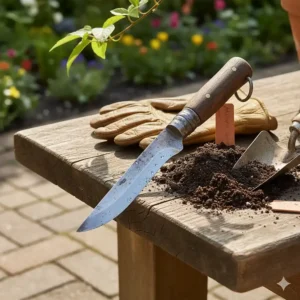
Essential Features to Consider in a Gardening Knife
Blade Material: Stainless Steel vs. Carbon Steel
The material choice dramatically affects your tool’s performance and maintenance requirements. According to research from the USDA, stainless steel resists rust naturally, requiring minimal maintenance beyond occasional wiping. It’s lighter weight and perfect for gardeners who sometimes forget tools outside overnight (we’ve all been there). However, it typically requires more frequent sharpening than carbon steel alternatives.
Carbon steel, while less common in modern knives for gardening, offers exceptional edge retention and can be sharpened to a razor edge. The tradeoff? It demands more attention—you’ll need to keep it dry and occasionally oil it to prevent rust. Professional landscapers often prefer carbon steel despite the maintenance, but most home gardeners find stainless steel’s convenience wins out.
Handle Design and Ergonomics
Your handle makes or breaks the user experience during extended sessions. Wooden handles provide classic aesthetics and excellent grip, developing a comfortable patina over time. However, they may crack if left in extreme temperature changes or require occasional treatment with mineral oil.
Rubberized or synthetic handles like Fiskars’ SoftGrip or WORKPRO’s TRP offer superior performance in wet conditions. They’re virtually maintenance-free and typically lighter weight. The ergonomic contouring reduces hand fatigue during marathon weeding sessions. Some gardeners find them less aesthetically pleasing than natural wood, but function often trumps form when your hands ache after hours of work.
Blade Length and Shape Considerations
Blade length typically ranges from 3 to 8 inches. Longer blades (7-8 inches) provide greater digging depth and leverage but add weight. They excel at dividing large perennials and working in raised beds. Shorter blades (3-5 inches) offer precision and portability—perfect for detail work and carrying in your pocket.
The curved or concave blade shape isn’t just aesthetic; it serves a practical purpose. That gentle scoop makes lifting soil and small plants effortless. The depth markings etched into most blades eliminate guesswork when planting bulbs at proper depths, ensuring better success rates with spring bloomers.
Full-Tang vs. Partial-Tang Construction
Full-tang construction means the blade metal extends completely through the handle, typically visible as a continuous piece secured with rivets. This design provides maximum strength and durability, especially important for prying tasks or working in rocky soil. Products like the PERWIN and Garden Guru feature this premium construction.
Partial-tang knives have blades that extend only partway into the handle. They’re typically lighter and often less expensive, perfectly adequate for lighter gardening tasks. For casual gardeners doing routine maintenance, partial-tang tools offer excellent value. Serious gardeners tackling tough jobs should invest in full-tang durability.
How to Choose the Perfect Gardening Knife for Your Needs
Step 1: Assess Your Primary Gardening Tasks
Start by honestly evaluating what you’ll actually do with this tool. If you primarily maintain flower beds and harvest vegetables, a lighter, more maneuverable option like the Opinel works beautifully. For heavy-duty landscaping, root removal, and dividing mature perennials, invest in robust options like the Nisaku or Garden Guru.
Step 2: Consider Your Hand Size and Strength
Manufacturers rarely discuss this, but hand size matters enormously. Smaller hands may struggle with thick handles, while larger hands find thin handles uncomfortable during extended use. If possible, hold similar tools at a local garden center to gauge comfort. Generally, handles around 4.5-5.5 inches accommodate most adults comfortably.
Step 3: Evaluate Your Budget Realistically
Quality gardening knives range from $13 to $60+. Budget options under $20 handle basic tasks adequately but may need replacement every 2-3 years. Mid-range tools ($25-40) typically last 5-10 years with proper care. Premium options ($40+) often become lifetime companions, making their higher initial cost a smart long-term investment.
Step 4: Match the Tool to Your Soil Type
Sandy, loose soil forgives almost any tool. Clay or rocky soil demands sturdy construction with full-tang blades that won’t bend or break under stress. If you’re battling compacted earth or established root systems, skip budget options entirely—invest in professional-grade tools with proven durability like the Nisaku or Garden Guru.
Step 5: Factor in Maintenance Preferences
Be honest about your maintenance habits. If you’re the type who occasionally leaves tools outside or forgets to clean them, choose stainless steel with minimal maintenance requirements. For those who enjoy caring for quality tools and appreciate traditional craftsmanship, carbon steel or premium wood-handled options provide greater satisfaction.
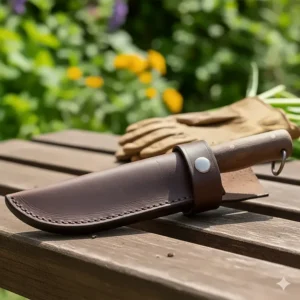
Proper Maintenance and Care Tips
Cleaning After Each Use
Never underestimate the importance of post-session cleaning. Soil contains moisture, minerals, and organic acids that gradually corrode even stainless steel. After each gardening session, wipe the blade with a slightly damp cloth to remove soil and debris. For stuck-on material, use a stiff brush—never harsh chemicals that might damage protective coatings.
Wooden handles appreciate occasional attention too. Wipe them down with a dry cloth, and every few months, apply a thin coat of mineral oil or linseed oil. This prevents cracking and maintains the natural beauty of the wood. Synthetic handles require less fuss—simple soap and water cleaning keeps them looking new for years.
Sharpening Techniques
Even quality stainless steel dulls with regular use. Invest in a diamond sharpening stone or ceramic rod specifically designed for outdoor tools. Most garden knife blades feature a convex or slightly curved edge, different from kitchen knives. Maintain the original angle (typically 20-25 degrees) when sharpening.
For serrated edges, use a tapered diamond file that fits between the teeth. Work each serration individually, maintaining the original bevel angle. This sounds tedious, but serrated edges require sharpening far less frequently than straight edges—often just once or twice per season.
Storage Best Practices
Proper storage extends tool life dramatically. According to guidelines from the University of California Agriculture and Natural Resources, always store your gardening knife in its sheath when not in use—this protects both the blade and you from accidental cuts. Hang tools in a dry location rather than leaving them in damp sheds or garages where moisture accelerates corrosion.
For winter storage, apply a thin coat of mineral oil to metal parts before putting tools away for the season. This creates a protective barrier against humidity. Come spring, simply wipe off the oil, and your knife will be ready for action without a speck of rust.
Common Mistakes to Avoid When Using Garden Knives
Using Excessive Force
Perhaps the biggest newbie mistake involves treating a gardening knife like a pry bar or chisel. These tools excel at cutting, slicing, and controlled digging—not brute-force demolition work. Excessive force bends blades, loosens rivets, and can even crack wooden handles. If you encounter resistance that doesn’t yield to moderate pressure, reassess your approach rather than forcing the issue.
Instead, work around obstacles. Use the serrated edge for sawing rather than pushing straight through tough material. Let the sharp blade do the work—proper technique beats raw strength every time. This approach not only protects your tool but also reduces strain on your hands and back.
Neglecting Safety Precautions
Garden knives are, well, knives—sharp implements that demand respect. The American Society for Horticultural Science emphasizes proper safety protocols when using garden tools. Always cut away from your body, and keep your non-dominant hand clear of the blade path. When walking with your knife, keep it in its sheath. This sounds obvious, but emergency rooms regularly see gardening injuries from people carrying unsheathed blades.
Wear proper gardening gloves when working with these tools. Quality gloves protect against blisters, thorns, and accidental blade contact. Choose gloves that fit snugly rather than loose options that might catch on the blade or compromise your grip.
Ignoring Blade Condition
Continuing to use a dull blade creates multiple problems. First, it’s dangerous—dull blades require more force and are more likely to slip and cause injury. Second, it makes gardening unnecessarily exhausting. Third, it damages plants by crushing rather than cleanly cutting tissue, creating entry points for disease.
Check your blade regularly. A sharp knife should effortlessly slice through a piece of paper held vertically. If it tears or catches, it’s time for sharpening. Most gardeners should sharpen their primary gardening knife 2-4 times per season depending on usage intensity and soil conditions.
Comparing Garden Knives to Traditional Tools
| Feature | Gardening Knife | Trowel | Hand Fork | Weeding Tool |
|---|---|---|---|---|
| Digging Capability | Excellent | Good | Poor | Poor |
| Root Cutting | Excellent | Poor | Fair | Good |
| Precision Work | Excellent | Fair | Poor | Good |
| Durability | High | Medium | High | Medium |
| Versatility | Exceptional | Limited | Limited | Limited |
| Portability | Excellent | Good | Fair | Good |
| Price Range | $15-60 | $8-30 | $10-25 | $10-35 |
The comparison reveals why knives for gardening have become so popular—they consolidate multiple specialized tools into one versatile implement. A quality gardening knife replaces your trowel, pruning knife, weeding tool, and measurement guide, dramatically simplifying your tool collection.
Traditional trowels excel at scooping soil for potting but struggle with tough roots and precision work. Hand forks effectively loosen compacted soil but can’t cut through material. Dedicated weeding tools remove dandelions well but offer limited versatility. A proper gardening knife handles all these tasks competently, making it the ultimate multi-tool for serious gardeners.
Seasonal Gardening Tasks: When to Use Your Knife
Spring: Planting and Dividing Season
Spring represents prime time for your gardening knife. Use it to divide overcrowded perennials before they fully wake up—the sharp blade slices through root balls cleanly, minimizing plant stress. The depth markings ensure bulbs and tubers get planted at optimal depths for strong emergence.
Early-season weeding proves much easier than tackling established weeds later. Your knife’s combination of digging and cutting power makes quick work of dandel ions and other deep-rooted invaders. The soil’s typically moist and workable in spring, allowing the blade to penetrate easily without excessive force.
Summer: Maintenance and Harvesting
Throughout summer’s heat, your gardening knife becomes an indispensable harvesting tool. The sharp blade cleanly cuts asparagus spears, lettuce heads, and herb sprigs without damaging surrounding plants. As noted by Cornell University’s gardening resources, clean cuts promote faster plant healing and reduce disease risk. The serrated edge tackles tougher vegetables like rhubarb stalks and mature chard stems.
Summer also brings aggressive weed growth. Regular passes through beds with your knife prevent weeds from establishing deep root systems. The curved blade makes quick work of surface weeds, while the pointed tip targets deeper taproots before they become problematic.
Fall: Cleanup and Preparation
Autumn gardening involves cutting back spent perennials, dividing overgrown plants, and preparing beds for winter. Your knife’s cutting power makes quick work of tough stalks and woody stems that pruners might struggle with. Use it to dig out summer annuals and prepare spaces for fall planting of bulbs and garlic.
This season also works beautifully for dividing spring-blooming perennials. The cooler temperatures reduce transplant stress, and plants have all fall and winter to establish before next spring’s show. Your knife’s combination of digging and cutting capabilities makes these tasks efficient and plant-friendly.
Winter: Off-Season Tool Care
While northern gardens sleep under snow, winter provides perfect time for tool maintenance. Thoroughly clean your gardening knife, sharpen the blade, and apply protective oil to metal components. Inspect wooden handles for cracks or wear, and treat them with mineral oil to prevent winter’s dry air from causing damage.
For southern gardeners enjoying year-round growing seasons, winter’s cooler temperatures make it ideal for tackling tough tasks. The soil remains workable, and you’ll appreciate how your knife powers through roots that summer’s heat would have made rock-hard.
Expert Tips for Maximum Tool Longevity
Professional landscapers who use these tools daily offer valuable insights for making your investment last. First, develop a pre-use inspection ritual. Before each gardening session, examine your knife for loose rivets, cracks, or significant dulling. Catching issues early prevents minor problems from becoming major failures.
Second, match the task to the tool capability. Save your gardening knife for jobs it handles well—cutting, digging, and controlled prying. For hammer-required tasks, use an actual hammer. For heavy root sawing, consider a dedicated pruning saw. This prevents unnecessary stress that shortens tool life.
Third, invest in quality accessories. A proper sheath protects your blade and extends edge life significantly. A good diamond stone makes sharpening efficient and effective. These relatively small investments multiply your primary tool’s useful life exponentially.
Understanding Price vs. Value in Garden Tools
The garden tool market spans from $10 bargains to $100+ luxury options. Understanding this spectrum helps you make informed decisions rather than simply buying the cheapest or most expensive option.
Budget tools ($10-20) typically use thinner metal, partial-tang construction, and basic handles. They adequately serve casual gardeners with light-duty needs or those wanting to try the tool type before investing heavily. Expect 2-3 years of service with reasonable care.
Mid-range options ($20-40) represent the sweet spot for most gardeners. These tools use quality materials, often feature full-tang construction, and include better sheaths and accessories. With proper maintenance, they easily last 5-10 years, making their per-year cost remarkably low.
Premium tools ($40-60+) target professional users and serious enthusiasts. They feature top-tier materials, superior craftsmanship, and often include lifetime warranties. The higher initial investment pays off through decades of reliable service and reduced replacement costs.
Calculate the real cost-per-year rather than fixating on purchase price. A $40 tool lasting 10 years costs $4 annually. A $15 tool replaced every 2 years costs $7.50 annually while providing inferior performance. Quality often proves more economical long-term.
Environmental Considerations and Sustainability
Modern gardeners increasingly consider environmental impact when choosing tools. Several factors merit attention beyond simply the tool’s immediate function.
Manufacturing location affects carbon footprint significantly. Tools made in Japan or Europe like the Nisaku and Opinel travel further but often feature superior quality and longevity. This durability potentially offsets higher transportation emissions through reduced replacement frequency. Conversely, some Chinese-manufactured tools offer good value but may involve less transparent environmental practices.
Material sourcing matters too. Responsibly harvested wood handles, recycled steel blades, and minimal packaging all contribute to lower environmental impact. Companies like Garden Guru actively offset their carbon footprint and donate to environmental causes, aligning purchase decisions with personal values.
Durability represents perhaps the most significant environmental consideration. A tool lasting 10+ years drastically reduces waste compared to disposable options replaced every few years. Quality tools minimize landfill contribution while reducing the resource extraction and manufacturing energy needed for replacements.
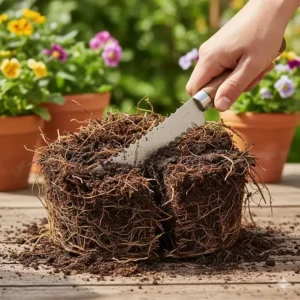
Frequently Asked Questions
❓ What makes a gardening knife different from a regular knife?
❓ How often should I sharpen my gardening knife?
❓ Can I use a gardening knife for harvesting vegetables?
❓ Are expensive gardening knives worth the investment?
❓ What safety precautions should I follow when using a garden knife?
Conclusion: Choosing Your Perfect Gardening Companion
After exploring seven outstanding products and diving deep into features, maintenance, and proper use, the verdict is clear: every serious gardener benefits from a quality gardening knife in their arsenal. Whether you’re tackling weeds, dividing perennials, or harvesting homegrown produce, the right tool transforms tedious tasks into efficient, even enjoyable work.
For most gardeners, the PERWIN Hori Hori offers exceptional value, combining durability and performance at a budget-friendly $20-36 price point. Those seeking ultimate quality should consider the Nisaku NJP650 with its authentic Japanese craftsmanship and decade-plus lifespan. Budget-conscious beginners will appreciate the Fiskars Big Grip at under $15, backed by a lifetime warranty that removes risk from the equation.
Remember, the best gardening knife is the one you’ll actually use. Consider your specific needs, gardening style, and budget constraints. Match the tool to your tasks—precision work vs. heavy-duty digging, occasional use vs. daily deployment. Invest in proper maintenance through regular cleaning and sharpening, and your knife will reward you with years of faithful service.
🌟 Transform Your Gardening Today!
Don’t let another season pass struggling with inadequate tools. Browse the highlighted products above to find your perfect match. Check current Amazon pricing and customer reviews to make an informed decision. Your back, your hands, and your garden will thank you! 🌱🛒
Recommended for You
- Best Watering Wand: 7 Top Picks for Effortless Garden Care in 2025
- Grass Seed Mulch: 7 Best Products for 2025 Success
- Best Rear Tine Rototiller: Top 7 Powerful Picks 2025
Disclaimer: This article contains affiliate links. If you purchase products through these links, we may earn a small commission at no additional cost to you.
✨ Found this helpful? Share it with your friends! 💬🤗

